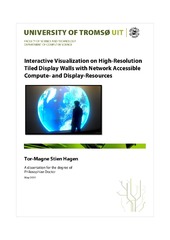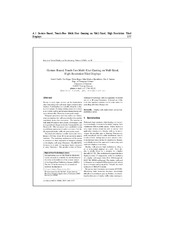| dc.contributor.advisor | Anshus, Otto | |
| dc.contributor.author | Hagen, Tor-Magne Stien | |
| dc.date.accessioned | 2011-11-04T14:34:09Z | |
| dc.date.available | 2011-11-04T14:34:09Z | |
| dc.date.issued | 2011-09-26 | |
| dc.description.abstract | The vast volume of scientific data produced today requires tools that can enable scientists to explore large amounts of data to extract meaningful information. One such tool is interactive visualization. The amount of data that can be simultaneously visualized on a computer display is proportional to the display’s resolution. While computer systems in general have seen a remarkable increase in performance the last decades, display resolution has not evolved at the same rate. Increased resolution can be provided by tiling several displays in a grid. A system comprised of multiple displays tiled in such a grid is referred to as a display wall. Display walls provide orders of magnitude more resolution than typical desktop displays, and can provide insight into problems not possible to visualize on desktop displays. However, their distributed and parallel architecture creates several challenges for designing systems that can support interactive visualization. One challenge is compatibility issues with existing software designed for personal desktop computers. Another set of challenges include identifying characteristics of visualization systems that can: (i) Maintain synchronous state and display-output when executed over multiple display nodes; (ii) scale to multiple display nodes without being limited by shared interconnect bottlenecks; (iii) utilize additional computational resources such as desktop computers, clusters and supercomputers for workload distribution; and (iv) use data from local and remote compute- and data-resources with interactive performance.
This dissertation presents Network Accessible Compute (NAC) resources and Network Accessible Display (NAD) resources for interactive visualization of data on displays ranging from laptops to high-resolution tiled display walls. A NAD is a display having functionality that enables usage over a network connection. A NAC is a computational resource that can produce content for network accessible displays. A system consisting of NACs and NADs is either push-based (NACs provide NADs with content) or pull-based (NADs request content from NACs).
To attack the compatibility challenge, a push-based system was developed. The system enables several simultaneous users to mirror multiple regions from the desktop of their computers (NACs) onto nearby NADs (among others a 22 megapixel display wall) without requiring usage of separate DVI/VGA cables, permanent installation of third party software or opening firewall ports. The system has lower performance than that of a DVI/VGA cable approach, but increases flexibility such as the possibility to share network accessible displays from multiple computers. At a resolution of 800 by 600 pixels, the system can mirror dynamic content between a NAC and a NAD at 38.6 frames per second (FPS). At 1600x1200 pixels, the refresh rate is 12.85 FPS. The bottleneck of the system is frame buffer capturing and encoding/decoding of pixels. These two functional parts are executed in sequence, limiting the usage of additional CPU cores. By pipelining and executing these parts on separate CPU cores, higher frame rates can be expected and by a factor of two in the best case.
To attack all presented challenges, a pull-based system, WallScope, was developed. WallScope enables interactive visualization of local and remote data sets on high-resolution tiled display walls. The WallScope architecture comprises a compute-side and a display-side. The compute-side comprises a set of static and dynamic NACs. Static NACs are considered permanent to the system once added. This type of NAC typically has strict underlying security and access policies. Examples of such NACs are clusters, grids and supercomputers. Dynamic NACs are compute resources that can register on-the-fly to become compute nodes in the system. Examples of this type of NAC are laptops and desktop computers. The display-side comprises of a set of NADs and a data set containing data customized for the particular application domain of the NADs. NADs are based on a sort-first rendering approach where a visualization client is executed on each display-node. The state of these visualization clients is provided by a separate state server, enabling central control of load and refresh-rate. Based on the state received from the state server, the visualization clients request content from the data set. The data set is live in that it translates these requests into compute messages and forwards them to available NACs. Results of the computations are returned to the NADs for the final rendering. The live data set is close to the NADs, both in terms of bandwidth and latency, to enable interactive visualization. WallScope can visualize the Earth, gigapixel images, and other data available through the live data set.
When visualizing the Earth on a 28-node display wall by combining the Blue Marble data set with the Landsat data set using a set of static NACs, the bottleneck of WallScope is the computation involved in combining the data sets. However, the time used to combine data sets on the NACs decreases by a factor of 23 when going from 1 to 26 compute nodes. The display-side can decode 414.2 megapixels of images per second (19 frames per second) when visualizing the Earth. The decoding process is multi-threaded and higher frame rates are expected using multi-core CPUs. WallScope can rasterize a 350-page PDF document into 550 megapixels of image-tiles and display these image-tiles on a 28-node display wall in 74.66 seconds (PNG) and 20.66 seconds (JPG) using a single quad-core desktop computer as a dynamic NAC. This time is reduced to 4.20 seconds (PNG) and 2.40 seconds (JPG) using 28 quad-core NACs. This shows that the application output from personal desktop computers can be decoupled from the resolution of the local desktop and display for usage on high-resolution tiled display walls. It also shows that the performance can be increased by adding computational resources giving a resulting speedup of 17.77 (PNG) and 8.59 (JPG) using 28 compute nodes.
Three principles are formulated based on the concepts and systems researched and developed: (i) Establishing the end-to-end principle through customization, is a principle stating that the setup and interaction between a display-side and a compute-side in a visualization context can be performed by customizing one or both sides; (ii) Personal Computer (PC) – Personal Compute Resource (PCR) duality states that a user’s computer is both a PC and a PCR, implying that desktop applications can be utilized locally using attached interaction devices and display(s), or remotely by other visualization systems for domain specific production of data based on a user’s personal desktop install; and (iii) domain specific best-effort synchronization stating that for distributed visualization systems running on tiled display walls, state handling can be performed using a best-effort synchronization approach, where visualization clients eventually will get the correct state after a given period of time.
Compared to state-of-the-art systems presented in the literature, the contributions of this dissertation enable utilization of a broader range of compute resources from a display wall, while at the same time providing better control over where to provide functionality and where to distribute workload between compute-nodes and display-nodes in a visualization context. | en |
| dc.description.doctoraltype | ph.d. | en |
| dc.description.popularabstract | Den stadig økende mengde vitenskapelige data produsert i dag krever verktøy som kan hjelpe oss å ekstrahere meningsfull informasjon fra slike store datamengder. Interaktiv visualisering er ett slikt verktøy. Avhandlingen presenterer en rekke bidrag knyttet til interaktiv visualisering av store datamengder i svært høy oppløsning, som blant annet kan framvises på høyoppløselige visningsvegger bestående av mange prosjektører og datamaskiner. Forskningen som er utført er systemforskning i informatikk, hvor arkitekturer og designer utformes og realiseres gjennom prototyper. Prototypene evalueres gjennom eksperimenter for å dokumentere hvordan de oppfører seg og hvilke ytelser de har. Som et resultat av forskningen er flere prinsipper og modeller dokumentert basert på en mengde prototyper. Forskningen har blant annet bidratt til å finne ut hvordan store datamengder effektivt kan visualiseres med svært høy oppløsning, hvordan data produsert av vanlige PC applikasjoner kan vises frem i både lav og høy oppløsning på andre PC’er og visningsvegger, og hvordan bærbare PC’er kan dele en eneste prosjektør på tvers av plattformer, uten å være avhengig av å bruke kabler eller forhåndsinstallerte kompatible remote desktop systemer. | en |
| dc.description.sponsorship | The Norwegian Research Council, in particular the following projects: (i) 159936/V30, SHARE – A Distributed Shared Virtual Desktop for Simple, Scalable and Robust Resource Sharing across Computer, Storage and Display Devices, and (ii) 155550/420, Display Wall with Compute Cluster. | en |
| dc.description | Papers number 2-7 and appendix B and C of this thesis are not available in Munin: <br/>2. Hagen, T-M.S., Johnsen, E.S., Stødle, D., Bjorndalen, J.M. and Anshus, O.: 'Liberating the Desktop', First International Conference on Advances in Computer-Human Interaction (2008), pp 89-94. Available at <a href=http://dx.doi.org/10.1109/ACHI.2008.20>http://dx.doi.org/10.1109/ACHI.2008.20</a> <br/>3. Tor-Magne Stien Hagen, Oleg Jakobsen, Phuong Hoai Ha, and Otto J. Anshus: 'Comparing the Performance of Multiple Single-Cores versus a Single Multi-Core' (manuscript)<br/>4. Tor-Magne Stien Hagen, Phuong Hoai Ha, and Otto J. Anshus: 'Experimental Fault-Tolerant Synchronization for Reliable Computation on Graphics Processors' (manuscript) <br/>5. Tor-Magne Stien Hagen, Daniel Stødle and Otto J. Anshus: 'On-Demand High-Performance Visualization of Spatial Data on High-Resolution Tiled Display Walls', Proceedings of the International Conference on Imaging Theory and Applications and International Conference on Information Visualization Theory and Applications (2010), pages 112-119. Available at <a href=http://dx.doi.org/10.5220/0002849601120119>http://dx.doi.org/10.5220/0002849601120119</a> <br/>6. Bård Fjukstad, Tor-Magne Stien Hagen, Daniel Stødle, Phuong Hoai Ha, John Markus Bjørndalen and Otto Anshus: 'Interactive Weather Simulation and Visualization on a Display Wall with Many-Core Compute Nodes', Para 2010 – State of the Art in Scientific and Parallel Computing. Available at <a href=http://vefir.hi.is/para10/extab/para10-paper-60>http://vefir.hi.is/para10/extab/para10-paper-60</a>
<br/>7. Tor-Magne Stien Hagen, Daniel Stødle, John Markus Bjørndalen, and Otto Anshus: 'A Step towards Making Local and Remote Desktop Applications Interoperable with High-Resolution Tiled Display Walls', Lecture Notes in Computer Science (2011), Volume 6723/2011, 194-207. Available at <a href=http://dx.doi.org/10.1007/978-3-642-21387-8_15>http://dx.doi.org/10.1007/978-3-642-21387-8_15<a/> | en |
| dc.identifier.isbn | 978-82-8236-040-1 | |
| dc.identifier.isbn | 978-82-8236-041-8 | |
| dc.identifier.uri | https://hdl.handle.net/10037/3672 | |
| dc.identifier.urn | URN:NBN:no-uit_munin_3387 | |
| dc.language.iso | eng | en |
| dc.publisher | Universitetet i Tromsø | en |
| dc.publisher | University of Tromsø | en |
| dc.rights.accessRights | openAccess | |
| dc.rights.holder | Copyright 2011 The Author(s) | |
| dc.rights.uri | https://creativecommons.org/licenses/by-nc-sa/3.0 | en_US |
| dc.rights | Attribution-NonCommercial-ShareAlike 3.0 Unported (CC BY-NC-SA 3.0) | en_US |
| dc.subject | VDP::Teknologi: 500::Informasjons- og kommunikasjonsteknologi: 550::Datateknologi: 551 | en |
| dc.subject | VDP::Technology: 500::Information and communication technology: 550::Computer technology: 551 | en |
| dc.title | Interactive Visualization on High-Resolution Tiled Display Walls with Network Accessible Compute- and Display-Resources | en |
| dc.type | Doctoral thesis | en |
| dc.type | Doktorgradsavhandling | en |


 English
English norsk
norsk

